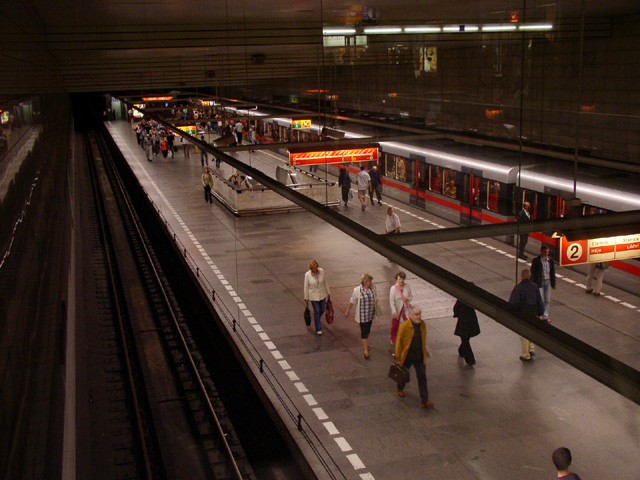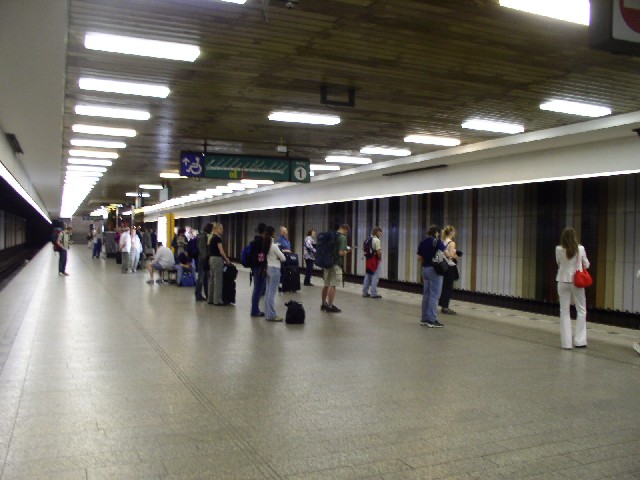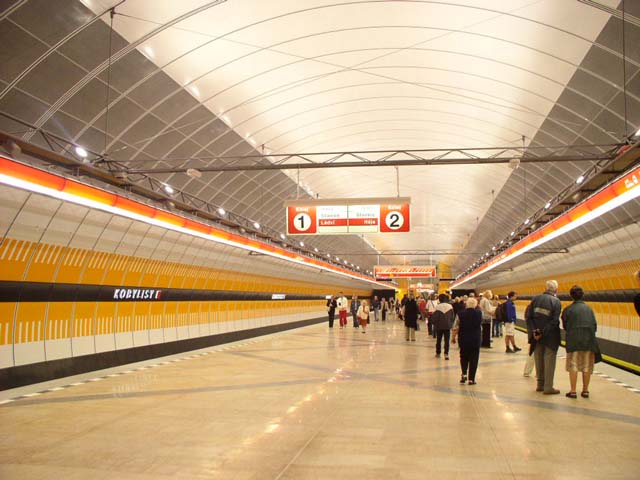history











|
In the early 1960s the concept of the sub-surface tramway was finally accepted and on 9 August 1966 the actual building of its first station (Hlavní Nádraží) started. Therefore this station's design reflects partly the original intention to build and underground tramway. However, next year a substantial change in the concept came, as the government decided to build a "true" metro system instead of an underground tramway. It was mainly because such metro systems were "fashionable" in the Soviet Union and there was a political decision to import the soviet metro trains, as you can read here. Thus, during the first years, the construction continued while the whole project was conceptually transformed. The regular service of the first nine-stations section of line C between Sokolovská (now Florenc) and Kačerov stations began operating on 9 May 1974, with a depot at Kačerov.
Construction of next sections continued then quite rapidly. On 12 August 1978 the first section of line A was opened with seven stations in total between Dejvická and Náměstí míru, meeting line C at Muzeum, which became the first transfer station. While all stations on line C had been built using the cut-and-cover method, on line A there were the first deep level bored stations (Náměstí míru with the depth 52 m being the deepest metro station in Prague up to now). In 1980 two extensions were copmleted at both lines: Line A thus reaching Želivského in the east and line C Kosmonautů (now Háje) in the southeast. The latter extension with four stations in total serves a large suburb consisting of high density housing estates called Jižní Město - "Southern Town" in Czech, which is the largest and densest housing estate in the Czech republic. Another extension of line C was opened in 1984 and reached Nádraží Holešovice. Finally, on 2 November 1985, the first seven-stations section of line B opened with termini at Smíchovské nádraží and Sokolovská, thus forming the triangle of the three transfer stations (the new ones were Můstek with line A and Sokolovská (now Florenc) with line C).
In the following years, except two stations added to line A in the east, primarilly line B was extended. These two new stations on line A were Strašnická (opened 1987) and Skalka, which was interesting, because it was built in 1990 along the already operational tracks from the then terminus Strašnická to a depot in Hostivař.
The first extension of line B in 1988 from Smíchovské nádraží reached Nové Butovice in the west. The next one in 1990 added four more stations in the east, with a new terminus at Českomoravská. Another extension was put into service in 1994. It goes to the west from Nové Butovice to Zličín and together with it, a new depot for line B was built in Zličín (before that, whole line B had been served from the Kačerov depot on line C). The last extension of line B reached Černý Most in the east and was opened in 1998. There were four intermediate stations, but two of them were to be completed only later. Thus the Hloubětín station was opened in 1999 and Kolbenova in 2001. At that time, line B was completed and there would be probably no more extensions of it during the following decades.
In the meantime, the old Russian and slowly wearing out trains are being reconstructed and replaced. The renewal of the rolling stock should be completed by 2007. You can read more about it in the rolling stock section.
In August 2002, the metro suffered disastrous flooding that struck parts of Bohemia and other areas in Central Europe. 19 stations were flooded: Malostranská, Staroměstská, Můstek and Muzeum on line A; Smíchovské nádraží, Anděl, Karlovo náměstí, Národní třída, Můstek, Náměstí Republiky, Florenc, Křižíkova, Invalidovna, Palmovka, Českomoravská and Vysočanská on line B; Nádraží Holešovice, Vltavská and Florenc on line C. It caused partial collapse of the transport system in Prague, the metro lines had to be substituted by trams and buses. The affected sections of the metro stayed out of service for several months, the last stations (Křižíkova and Invalidovna, located in the most damaged area - Karlín) reopened on 22 March 2003. Small silver plates have been placed at some stations to show the water level during the event. The costs of the recovery was around 7000000000 CZK (approximately 250 million ).
A northern extension of the line C was opened on 26 June 2004, with two more stations, Kobylisy and Ládví. Notable is the way that the new tunnels were built under the Vltava river. A unique "ejecting-tunnels" technology had been chosen to underpass the river. First, a trench had been excavated in the riverbed and the tunnels had been concreted in the dry docks on the riverbank. Then the docks had been flooded, and the afloat tunnels were moved as a rigid complex to their final position, sunk, anchored and covered.
In the May 2006 a small extension of line A to the east was opened. The extension includes one new station, Depo Hostivař, which is placed in a depot.
Another extension of line C was opened on 8 May 2008. There are three new stations: Střížkov, Prosek and Letňany.
There are further projects to start building a completely new line, the D line, represented by the blue color, afterward. It should connect the centre to the southern parts of the city and go from Hlavní nádraží through the Nusle quarter down to the Krč, Libuš and Písnice suburbs in the south. If the project goes well, the first sections of the line will begin operation around 2013.
timeline
| 1898 | First proposal by Ladislav Rott to build an underground railway in Prague. | |
|---|---|---|
| 1926 | The first detailed project of a metro system for Prague proposed by Vladimír List and Bohumil Belada. | |
| 6 January 1966 | An underground tramway construction began along the current line C. | |
| 9 August 1968 | The government made a decision to build a real metro system instead of the underground tramway. | |
| 9 May 1974 | The first secion of line C opened with stations Sokolovská (now Florenc), Hlavní nádraží, Muzeum, I. P. Pavlova, Gottwaldova (now Vyšehrad), Pražského povstání, Mládežnická (now Pankrác), Budějovická and Kačerov | |
| 12 August 1978 | Line A opened in the first seven-stations section: Leninova (now Dejvická), Hradčanská, Malostranská, Staroměstská, Můstek, Muzeum (transfer station with line C) and Náměstí míru. | |
| 7 November 1980 | The secont part of line C is opened in the south. The stations on it are Primátora Vacka, Budovatelů, Družby and Kosmonautů (now Roztyly, Chodov, Opatov and Háje, respectively). | |
| 19 December 1980 | An extension of line A from Náměstí Míru is opened with three new stations: Jiřího z Poděbrad, Flora and Želivského. | |
| 3 November 1984 | Line C reaches Fučíkova (now Nádraží Holešovice) in the north, with one intermediate station Vltavská. | |
| 2 November 1985 | The first section of line B is opened between Smíchovské nádraží and Sokolovská with intermediate stations Moskevská (now Anděl), Karlovo náměstí, Národní třída, Můstek and Náměstí republiky. It crossed line A at Můstek and line C at Sokolovská. | |
| 11 July 1987 | Line A reaches Strašnická in the east. | |
| 26 October 1988 | An extension of line B from Smíchovské nádraží opened, with three new stations: Radlická, Švermova (now Jinonice) and Dukelská (now Nové Butovice). | |
| 22 February 1990 | 12 stations with names reflecting Communist ideology were changed to be politically neutral. | |
| 4 July 1990 | A new station Skalka added to line A in the east. | |
| 22 November 1990 | An eastward extension of line B is opened from Florenc with stations Křižíkova, Invalidovna, Palmovka and Českomoravská. | |
| 11 November 1994 | Another extension of line B goes from Nové Butovice with new stations Hůrka, Lužiny, Luka, Stodůlky and Zličín. | |
| 4 February 1996 | The first train of the modernised 8171M series in regular service on line C. | |
| 29 June 1997 | The end of the regular service of the Ečs series trains on line C. | |
| 8 November 1998 | Line B extension from Českomoravská opened with stations Vysočanská, Rajská zahrada and Černý Most. Two more intermediate station to be finished only later. | |
| 15 October 1999 | Hloubětín station opened between Vysočanská and Rajská zahrada on line B. | |
| 8 June 2001 | Kolbenova station opened between Vysočanská and Hloubětín on line B. | |
| 27 January 2000 | The first train of the new M1 series in service with passengers on line C. | |
| 13-15 August 2002 | Heavy flooding struck Prague, 19 stations flooded. | |
| 22 March 2003 | Last stations (Křižíkova, Invalidovna) reopened after restoration from the flooding. | |
| 26 June 2004 | A northward extension of line C opened with new stations Kobylisy and Ládví. | |
| 26 May 2006 | A new station Depo Hostivař located in a depot opened on line A | |
| 8 May 2008 | Another extension on the northern end of line C with three new stations: Střížkov, Prosek and Letňany. | |